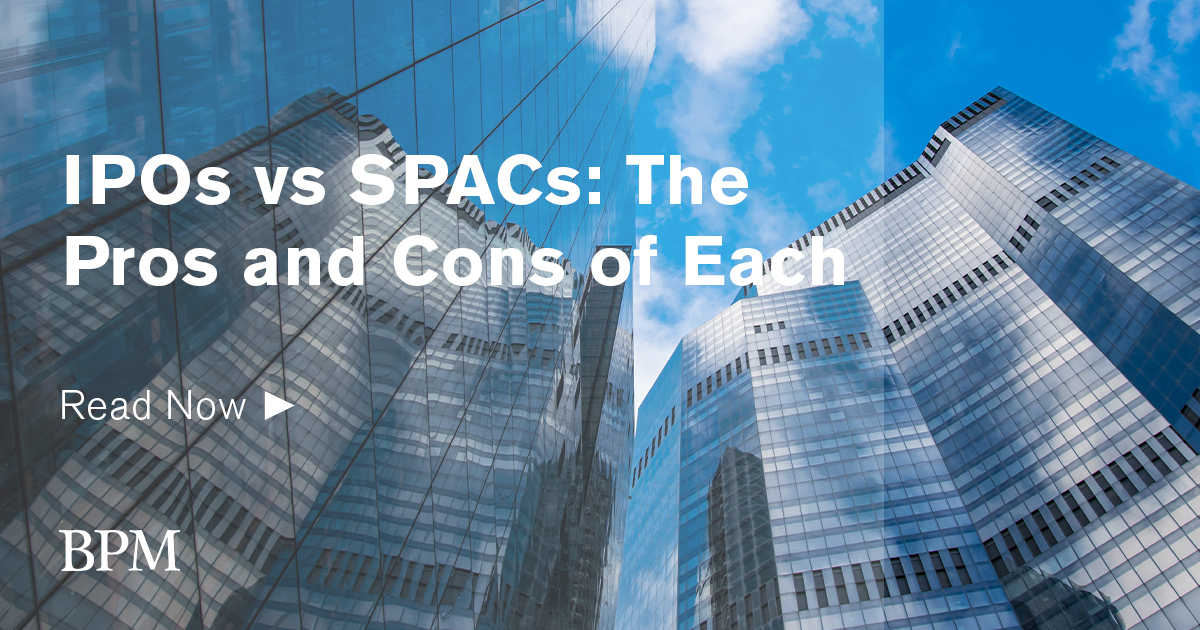INSIGHT
SPACs vs. traditional IPOs: Key advantages of going public the easy way
Craig Hamm • May 24, 2021
Services: Business Valuation
SPAC activity is red-hot in 2021, but is it the best choice for a technology company looking to go public?
By Craig Hamm
Initial public offerings (IPO) have been around for a long time — longer than you may realize. The Dutch East India Company was the first company to go through the IPO process back in 1602. It was also the first company to issue bonds and have shares listed on an official stock exchange. The company's main focus was to bring luxury goods, including spices, silk and porcelain, from Asia to Europe, and it was a highly successful venture. In fact, at its peak, some analysts estimate the value of the Dutch East India Company at nearly $8 trillion in today's money. That's more than the market caps of Apple, Microsoft, Amazon, and Google’s parent company, Alphabet, combined.
In the 419 years since this first IPO, hundreds of thousands of companies have gone through a similar process to raise capital and begin trading. However, there are a couple of other ways for a company to go public. In the past few years, special-purpose acquisition companies (SPAC) have grown more popular for both companies and investors, and tech companies have been the targets of some of the largest SPAC deals. Both methods have pros and cons, so a company needs to speak with a professional before deciding on either course of action.
What is an IPO?
First, let us take a quick look at what goes into an IPO. When a company is mature and has enough value, it might be time to go public. The first course of action is to find an underwriter, which is usually an investment bank. The underwriter leads the IPO and helps with the logistics on everything including setting the offering price, determining the number of shares, and setting a timeline for the stock debut. The underwriter will work with the company to file paperwork with the Securities Exchange Commission (SEC) and other regulators and the various exchanges (such as the New York Stock Exchange and NASDAQ) that the shares will trade on. Together, the underwriter and the company will market the IPO to build interest in the offering and hold roadshows to meet large institutional investors.
There are several advantages of going through a traditional IPO. In addition to being an efficient way to raise money to help grow the company or fund research and development, the process helps boost interest in the company among professional investors. It also helps set the IPO price to minimize the risk of embarrassing backsliding once the shares start to trade.
However, there are a few disadvantages to consider. It often takes many months to prepare financial statements and disclosures, meet regulatory requirements, and then sell the company to institutional investors. There is always a risk that the IPO will not raise the expected amount of cash. It can also be expensive because underwriters charge a fee and take a commission ranging between 3% and 7%.
What is a SPAC?
A SPAC, also known as a "blank check company," is a shell corporation listed on the stock exchange that has no products or sales. Private equity funds usually create a SPAC for the sole purpose of purchasing a private company and taking it public without going through an IPO. The SPAC attracts investors (both retail and institutional) with a promise that it will use the funds to buy a viable company within a set time, usually two years. Once a company has been targeted, the investors vote on whether to proceed or cancel the purchase. If no deal is made, the investors' money is refunded with interest.
SPACs have become very popular in the last few years. In the first quarter of 2021, 310 SPACs were launched, raising almost $93 billion. For comparison, SPACs raised less than $82 billion for all of 2020. In early April, Asian ride-hailing and fintech giant Grab announced it would go public through a merger with a SPAC for a record-setting amount of nearly $40 billion. Other big SPAC deals include DraftKings, Playboy Enterprises and WeWork, which came after the office-sharing startup's IPO fell apart in 2019.
SPACs have several advantages. For the company, a SPAC can provide guidance to help prepare it for going public. The process of this reverse listing is also significantly quicker than the traditional IPO route, and is significantly less expensive. These deals are also less dependent on the market to be successful. Unlike traditional IPOs, a company being acquired by a SPAC is allowed to make forward-looking projections, which could help attract investors. Finally, there is ownership flexibility through a deal with a SPAC. Some deals involve a total acquisition of a company, while some are structured so that the SPAC is a partner that provides liquidity and support to the existing managers and owners.
There are some disadvantages of a SPAC. No capital is raised through the reverse listing, which could be an issue in the future. The company also may not be prepared for the regulatory burden of filing quarterly reports or investor prospectuses. And as part of the deal, the manager of the SPAC gets a "promote." This is usually an additional 20% of shares on top of the stock being created for investors, so the deal's overall value gets diluted. Finally, SPACs typically have a two-year deadline to make a deal, so managers are incentivized to get something done, rather than holding out for the best deal. On top of that, there are now hundreds of SPACs looking for buyout targets, which could cause bidding wars that could overvalue a company and hurt the share price going forward.
Which is the best choice? It Depends.
For company owners, managers and early investors, IPOs and SPACs likely represent the most lucrative exit strategies. However, they both have their risks and rewards. A traditional IPO is expensive and time-consuming, but gives company management a taste of the regulatory rigor a publicly-traded company faces. SPACs are faster and cheaper, but companies that participate could be unprepared to face the regulatory challenges that public companies face. Due to the complexities of these deals, business leaders should consult with a trusted professional who knows the ins and outs of these kinds of deals.
BPM IPO and SPAC Assessment Services for Tech Companies
As you embark down the IPO or SPAC path, the preparations can start to seem overwhelming fast. BPM can help ease you through. Our Transaction Advisory Group is fully equipped to assist with numerous aspects of IPO and SPAC preparation, on projects both large and small. We will perform an initial assessment of your readiness for an IPO or a SPAC, giving you our honest analysis of your strategy. If there is alternative transaction strategy that is best for you, we will let you know. Post-assessment, BPM will identify and prioritize the technical next steps for the business.
It is never too early to start enhancing your systems and structures, if an IPO or SPAC is on the horizon. Contact Craig Hamm, Partner and Transaction Advisory Group Leader, today to learn more.

Craig Hamm
Partner, Advisory
BPM Board of Directors
Craig leads BPM’s Transaction Advisory Group with a focus in financial due diligence and quality of earnings services. Craig directs …
Start the conversation
Looking for a team who understands where you’re headed and how to help you get there? Whether you’re building something new, managing growth or preserving success, let’s talk.
